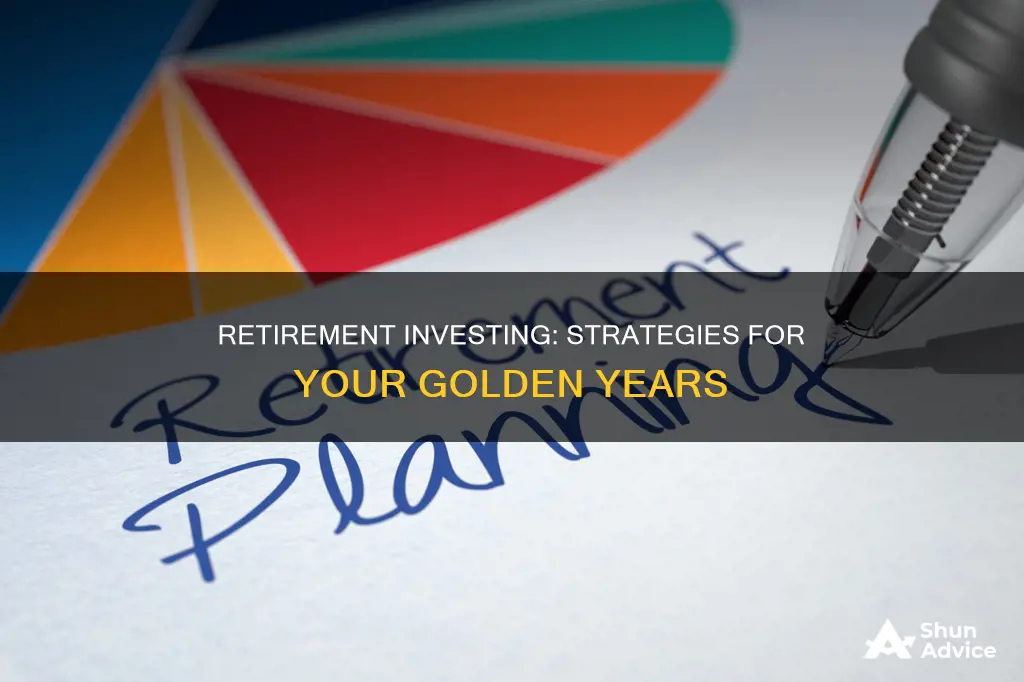
Planning for retirement can be a daunting task, but investing wisely can help you secure your financial future. Here are some strategies to help you get started on your retirement investing journey:
- Start early: The power of compounding means that the earlier you start saving and investing, the more your money will grow over time.
- Understand your options: Educate yourself about the different types of retirement savings accounts and investments available, such as tax-advantaged accounts (e.g. 401(k), IRA) and taxable accounts.
- Diversify your portfolio: Spread your investments across different asset classes, such as stocks, bonds, and cash, to reduce risk and improve potential returns.
- Consider a robo-advisor or target date fund: These automated investment services can help you maintain a well-balanced portfolio with minimal upkeep.
- Invest in dividend-paying stocks: Dividend stocks provide a steady income stream and can be a good option for those seeking consistent returns.
- Explore alternative investments: Look beyond traditional stocks and bonds; consider real estate, annuities, or qualified longevity annuity contracts (QLACs) to diversify your retirement portfolio.
- Seek professional advice: Consult a financial advisor to help you navigate the complexities of retirement planning and investing.
| Characteristics | Values |
|---|---|
| Investment options | Bonds, annuities, income-producing equities, diversified bond portfolio, total return investment approach, dividend-paying stocks, rental property, annuities, qualified longevity annuity contracts (QLACs) |
| Tax-advantaged accounts | 401(k)s, IRAs, brokerage accounts, Roth 401(k)s, Roth IRAs, SEP IRAs, SIMPLE IRAs, solo 401(k)s, HSAs, 529 plans |
| Asset allocation | 90% to 100% stocks, 0% to 10% bonds (20s and 30s), 40% to 60% stocks, 30% to 50% bonds, 0% to 10% cash/cash-equivalents (60s), 20% to 50% stocks, 40% to 60% bonds, 0% to 20% cash/cash-equivalents (70+) |
| Management options | Robo-advisors, target date funds |
| Investment types | Mutual funds, index funds, ETFs, individual stocks and bonds, dividend-paying stocks, real estate, REITs, fixed annuities, variable annuities, index annuities |
| Retirement plans | Defined contribution plans, traditional pensions, guaranteed income annuities, Federal Thrift Savings Plan, cash-value life insurance plan, nonqualified deferred compensation plans, HSAs, 529 plans |
What You'll Learn

Understand your options
There are many options to consider when investing for retirement. Here are some of the most common types of retirement investments and accounts:
- Tax-Advantaged Accounts: These accounts offer tax benefits, such as tax-deferral or tax-free withdrawals, and include 401(k)s, IRAs (Individual Retirement Accounts), and Roth accounts. 401(k)s are typically offered by employers, while IRAs can be opened at a bank or brokerage firm. Roth accounts allow you to invest with after-tax money and offer tax-free withdrawals in retirement.
- Defined Contribution Plans: These plans, including 401(k)s, 403(b)s, and 457(b)s, are funded by employees and offer tax advantages and, sometimes, employer matching contributions. 401(k)s and 403(b)s are commonly offered by employers, while 457(b)s are available to state and local government employees.
- Traditional Pensions: These are employer-funded defined benefit plans that provide a fixed monthly benefit to retirees. However, traditional pensions are becoming less common.
- Guaranteed Income Annuities (GIAs): GIAs are purchased by individuals to create their own pensions. They can be bought on an after-tax basis or within an IRA, and they provide a guaranteed income stream for life.
- The Federal Thrift Savings Plan (TSP): The TSP is similar to a 401(k) but is available to government workers and members of the uniformed services. It offers low-cost investment options and employer contributions, making it an attractive choice.
- Cash-Value Life Insurance Plans: Offered by some companies as a benefit, these plans provide a death benefit while building cash value that can support retirement needs. Withdrawals of the cash value may be tax-free under certain conditions.
- Nonqualified Deferred Compensation Plans (NQDCs): NQDCs are typically only offered to top executives and provide tax-deferred savings. However, they may not offer the same level of security as other plans.
- Health Savings Accounts (HSAs): While HSAs are designed for healthcare expenses, they can also be used as supplemental retirement accounts. They offer tax advantages similar to traditional retirement accounts.
- 529 Education Savings Plans: Originally intended for education expenses, 529 plans can now be used to fund a Roth IRA, providing additional flexibility for retirement savings.
When considering your investment options, it's important to evaluate the tax advantages, employer contributions, portability, potential returns, and level of control offered by each type of account or investment. Additionally, it's crucial to start saving and investing for retirement as early as possible to take advantage of compound growth over time.
Outside Investment: Blessing or Cash Flow Curse?
You may want to see also

Start early
Starting early is one of the most important steps you can take when planning for retirement. The earlier you start saving, the more time your money has to grow. This is due to the power of compound interest, which is the process by which a sum of money grows exponentially over time as interest is earned on both the initial sum and the reinvested earnings. The longer your money is invested, the more time it has to benefit from compound interest.
For example, if you invest $1,000 in a long-term bond that earns 3% interest per year, at the end of the first year, your investment will grow by $30 to $1,030. In the second year, you'll earn 3% of $1,030, so your investment will grow by $30.90. By the 39th year, your investment will be worth around $3,167, and by the 40th year, it will be worth $3,262.04. That's a one-year difference of $95, demonstrating how compound interest can accelerate the growth of your savings over time.
Starting early also gives you more time to recover from any investment losses and allows you to take advantage of higher-risk/higher-reward investments. It also means you'll have more years to save, resulting in a larger nest egg by the time you retire. Additionally, starting early helps you develop expertise in a wider variety of investment options and makes saving and investing a lifelong habit, improving your odds of a comfortable retirement.
If you're in your 20s, retirement may seem like a distant prospect. However, it's important to remember that building a sizable nest egg becomes more challenging the closer you get to retirement age. Starting early allows you to save at a slower pace, as compound interest works its magic. It's also easier to save for retirement when you're young, as you may have fewer financial responsibilities, such as a mortgage or a family.
So, if you're thinking about retirement, don't delay. Start saving and investing early to give your money the time it needs to grow and benefit from compound interest. It's one of the smartest financial decisions you can make.
Python in Investment Banking: A Common Tool?
You may want to see also

Calculate your net worth
Calculating your net worth is a crucial step in understanding your financial standing and progress towards your retirement goals. Net worth is essentially the difference between what you own (your assets) and what you owe (your liabilities). Here's a step-by-step guide to calculating your net worth:
Step 1: Identify Your Assets
Assets refer to everything you own that has monetary value. This includes:
- Cash and cash equivalents: Savings accounts, treasury bills, certificates of deposit (CDs), etc.
- Securities: Stocks, mutual funds, exchange-traded funds (ETFs), and other investments.
- Real estate: Your primary residence, rental properties, or any other real property.
- Personal property: Vehicles, jewelry, artwork, collectibles, and household furnishings.
Step 2: Determine Your Liabilities
Liabilities are your financial obligations or debts. This includes:
- Loans: Student loans, personal loans, mortgage, etc.
- Credit card balances: Any outstanding credit card debt.
- Other financial obligations: Child support payments or other loans.
Step 3: Calculate the Difference
Once you have a comprehensive list of your assets and liabilities, it's time to calculate your net worth using the following formula:
Net worth = Assets – Liabilities
Subtract the total value of your liabilities from the total value of your assets, and the resulting number is your net worth. It's important to note that your net worth can fluctuate over time as the value of your assets and liabilities change.
Calculating your net worth provides a clear snapshot of your financial situation and can be a powerful tool for financial planning. It allows you to:
- Set realistic financial goals: By understanding your current financial position, you can set specific and achievable retirement goals.
- Make informed decisions: Knowing your net worth helps you identify areas for improvement, such as increasing investments or reducing debt.
- Develop a debt repayment strategy: Analyzing your liabilities can help you prioritize debt repayment and develop a plan to reduce loan balances over time.
- Improve cash flow management: Understanding your net worth can help you identify areas where expenses are high and make necessary adjustments to prioritize savings and investments.
- Diversify your investments: Calculating your net worth may reveal areas of your portfolio that are overweight or underweight, prompting you to reallocate your assets to mitigate market risks and tax liabilities.
- Plan your estate: Knowing your net worth is crucial for estate planning, especially if you have significant assets to distribute upon your death.
In summary, calculating your net worth is an essential step in financial planning for retirement. It provides a comprehensive view of your financial situation, enabling you to make informed decisions, set realistic goals, and take the necessary steps to achieve a secure retirement.
Fidelity Investments: High-Frequency Trading Strategies and Secrets
You may want to see also

Keep your emotions in check
Investing for retirement can be an emotional rollercoaster, with soaring highs and deflating lows. It's important to keep emotions in check to avoid making impulsive decisions that could negatively impact your long-term financial goals. Here are some strategies to help you keep your emotions in check when investing for retirement:
Set Financial Goals
Setting clear financial goals is essential to keep emotions in check. Define your retirement timeline and risk tolerance. For example, if you are saving for retirement in 30 years, you can afford to take more risks and have more time to recover from any losses compared to someone planning to retire in 5 years. Setting financial goals helps you stay focused on your long-term plan and avoid making impulsive decisions based on short-term market fluctuations.
Automate Decisions
Automating your investments can help remove emotions from the equation. Consider setting up regular contributions to your retirement plans or automatic withdrawals if you're already retired. This way, you buy or sell at regular intervals, sometimes at high prices and sometimes at low prices. This approach, known as dollar-cost averaging, has proven successful over time and helps you avoid emotional reactions to market events.
Avoid Checking Your Portfolio Too Frequently
Resist the urge to constantly monitor your investments. Checking your portfolio too often can lead to anxiety and impulsive decisions. Limit yourself to reviewing your investments monthly or quarterly and focus on sticking to your overall plan. This way, you avoid getting caught up in the short-term ups and downs of the market and maintain a long-term perspective.
Understand Your Investments and Their Risks
Conduct thorough research before investing. Understand the investment objectives, risks, and exit strategies. By doing your own research, you take full responsibility for your trades and avoid making emotionally charged decisions. Knowing the risks involved in your investments can help you stay calm during market volatility and make more informed choices.
Consult a Financial Advisor
Consider hiring a financial advisor or coach to provide an objective perspective. A financial professional can help you navigate the complexities of investing and offer guidance during turbulent times. They can also serve as a buffer between you and your investments, providing distance and helping you make more rational decisions. Remember, the goal is to put time between your impulse to act and your behaviour.
Avoid Financial Media During Crises
During financial crises, it's best to avoid excessive exposure to financial media. Market commentators may themselves be emotional, and their pessimistic outlook could influence your decisions. Stick to your investment plan and avoid making impulsive moves driven by fear or panic. Remember that market volatility is normal, and it's essential to focus on your long-term strategy.
Warren Buffett's Cash Investment Strategies Revealed
You may want to see also

Pay attention to fees
Fees can have a significant impact on your investment returns, so it's important to pay attention to them when investing for retirement. Here are some things to keep in mind:
Understand the Different Types of Fees
There are various fees associated with investing, such as management fees, transaction fees, and expense ratios. Management fees are typically charged by financial advisors or robo-advisors for their services. Transaction fees are incurred when buying or selling investments, such as stocks or funds. Expense ratios are annual fees charged by mutual funds or exchange-traded funds (ETFs) and are expressed as a percentage of your investment. It's important to understand the different types of fees you may encounter and how they can impact your returns.
Compare Fees Across Different Investment Options
Fees can vary significantly across different investment options. For example, mutual funds and ETFs with similar investment strategies may have different expense ratios. By comparing fees, you can identify options that offer lower costs without sacrificing performance. This can help you maximize your returns over time.
Assess the Value Provided by the Fees
It's important to consider the value you're receiving in exchange for the fees. For example, a financial advisor who charges higher fees may provide more personalized advice and better investment recommendations. On the other hand, a robo-advisor with lower fees may offer automated investment management based on your risk tolerance and financial goals. Evaluate whether the fees align with the level of service and expertise you require.
Consider the Impact of Fees on Your Returns
Even small differences in fees can have a significant impact on your investment returns over time. For example, consider two funds with the same annual return but different expense ratios. The fund with the lower expense ratio will provide you with higher net returns. Compound interest will further amplify the effect of fees over time, so it's crucial to factor this into your decision-making.
Regularly Review and Adjust Your Investments
Fees can change over time, and new, lower-fee options may become available. It's important to periodically review the fees you're paying and compare them with alternative investments. If you find that you're paying excessive fees, consider switching to lower-fee options or negotiating with your current provider. This proactive approach will help ensure that your returns are not unnecessarily eroded by high fees.
Understanding the Cash Flows Statement: Investing Activities
You may want to see also
Frequently asked questions
There are several types of retirement accounts, including 401(k)s, 403(b)s, 457(b)s, IRAs (traditional, Roth, spousal, rollover, SEP, and SIMPLE), pensions, and solo 401(k)s. Each has its own set of benefits, contribution limits, and tax implications.
There are various investment options to consider for retirement, including stocks, bonds, mutual funds, exchange-traded funds (ETFs), annuities, dividend-paying stocks, real estate, and rental properties. It's important to understand the risks and potential returns associated with each option and to diversify your portfolio to minimise risk.
The recommended savings rate varies depending on your income and expenses. A common rule of thumb is to save 10% to 15% of your income. However, it's essential to consider your personal circumstances, desired retirement age, and expected expenses during retirement.
When selecting investments for your retirement portfolio, it's crucial to consider your goals, risk tolerance, and time horizon. Diversification is key to reducing risk and increasing the potential for returns. It's recommended to maintain a balanced portfolio that includes a mix of stocks, bonds, and cash investments. As you approach retirement, you may need to adjust your allocation to focus more on income generation and capital preservation.







